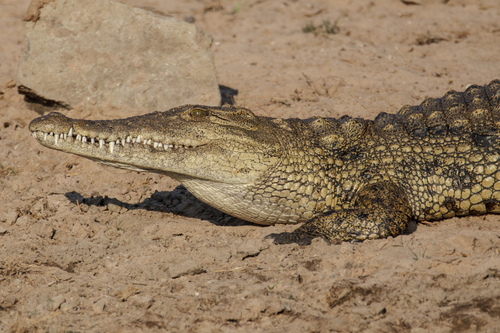
Nile Crocodile
Crocodylus niloticus, the formidable Nile crocodile, reigns in African waterways. These massive reptiles, with their stealthy, ambush tactics, are vital apex predators maintaining ecological balance. Their powerful physiques and opportunistic feeding habits make them both feared and revered in their natural habitats.
45 years
Lifespan
226.796 - 748.428 kg
Weight
Length: 4.88 - 6.1 m
Size
Dark, Brown, Olive
Color
10 years
Age of Sexual Maturity
22 mph
Top Speed
Least Concern
Conservation Status
Stable
Population Trend
Characteristics
The Nile crocodile, Crocodylus niloticus, is one of the largest reptile species, with adults averaging 4.5 meters in length. Found across Sub-Saharan Africa, they inhabit rivers, lakes, and marshlands. Known for their powerful jaws and ambush hunting style, they play a crucial role as apex predators in their ecosystems.
Distribution Range of the Nile Crocodile
Crocodylus niloticus, commonly known as the Nile crocodile, is native to sub-Saharan Africa. Its geographical distribution spans over several countries including, but not limited to, Egypt, Sudan, Ethiopia, Kenya, Tanzania, Uganda, Zambia, Zimbabwe, South Africa, and Madagascar. The species is predominantly found along river systems, lakes, freshwater wetlands, and reservoirs throughout this region.
Nile Crocodile's Habitat
Environmental Conditions
The Nile crocodile typically inhabits areas with a tropical or subtropical climate, characterized by warm temperatures and distinct wet and dry seasons. The species thrives in freshwater environments such as rivers, lakes, marshes, and along the edges of larger bodies of water. These habitats provide the necessary resources for basking, nesting, and hunting.
Ecological Niche
As a top predator, the Nile crocodile plays a crucial role in maintaining the balance of its ecosystem. It primarily feeds on fish, but its diet also includes birds, mammals, and occasionally carrion. The species is well-adapted to its aquatic environment, with strong swimming abilities and a keen sense of hearing and vision for hunting. Variations in habitat can occur due to regional adaptations, such as in Madagascar where the crocodile may inhabit more isolated or fragmented water bodies.
Copyright @ Nature Style Limited. All Rights Reserved.
 English
English